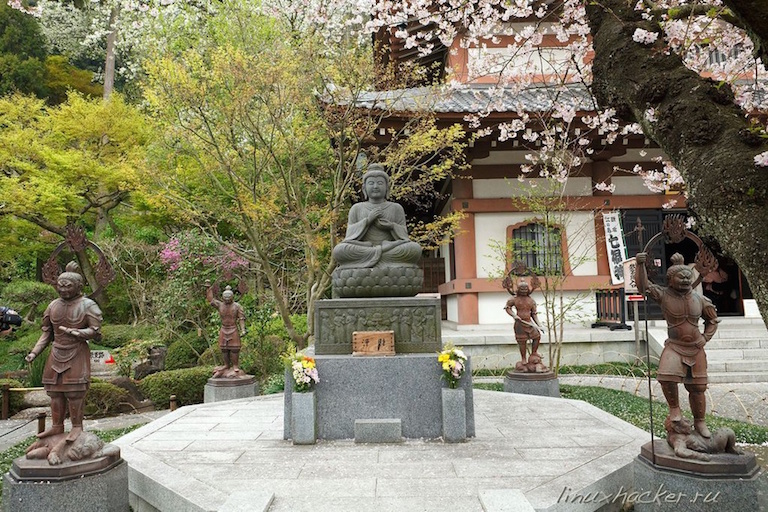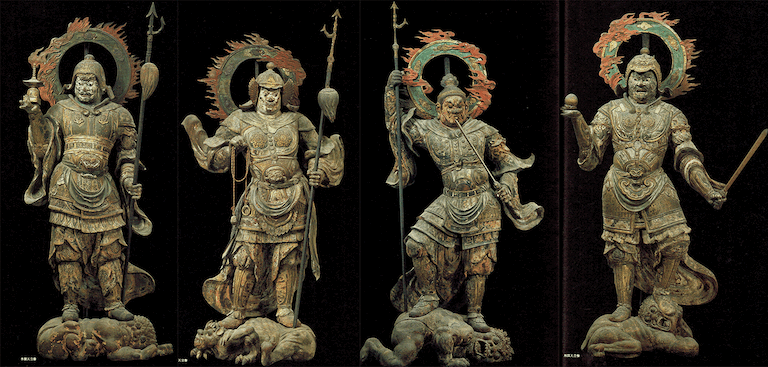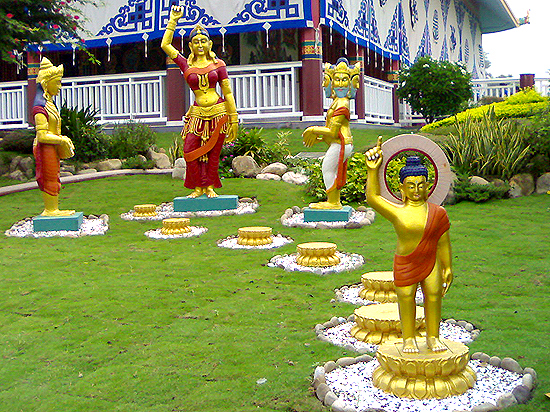Editor’s Note: Studying objective symbols such as the four heavenly gods in Buddhism, one can better understand the concept of the four “kings” of centers in the Fourth Way today.
The Four Kings of Centers and the Four Heavenly Kings
One of the basic concepts of the Fourth Way is the idea that man has four different brains instead of one. These four brains or lower centers are called the instinctive, moving, intellectual, and emotional centers. Each has its own function and intelligence. (Since the moving and instinctive centers function with the same energy and speed, they can be taken as one center. Thus Gurdjieff`s expression that man is a three-brained being.)
For a description of the lower centers see, in this issue, Balancing the Lower Centers.
The King of Hearts – Gateway to Higher States
The intellectual part of the emotional center is called the King of Hearts, the gateway to the state of self-remembering. This part of ourselves is referred to as “the heart” by many esoteric traditions.
The heart is the vital center. It occupies the place of ruler. It is the sacred vessel. — Yellow Emperor’s Inner Canon
Without attention or with attention wandering, we are in the mechanical parts of centers: with the attention attracted by the subject of observation or reflection and kept there, we are in the emotional part; with the attention controlled and held on the subject by will, we are in the intellectual part. — Ouspensky
Self-Remembering and the Kings of Centers
Self-remembering requires the functioning of the intellectual parts or “kings” of centers. Only when paying attention can one divide attention between what one is doing and being aware of oneself. The four heavenly kings, four gods from the Buddhist tradition, symbolize the four kings of centers. By studying the role of these four gods in Buddhism, one gains a better understanding of the role of the four kings of centers.

Four Heavenly Kings of Buddhism with Buddha in the Center
The human being is a city, with a special place at its center for the Lord’s deputy, where he resides with his governing officials. The place of the Lord’s deputy is the heart. — Ibn Arabi
It is said that the four heavenly kings listen to the Buddhist teachings and protect the place where the Buddha expounds them. This means that the kings of centers listen to the teaching on awakening and try to protect the steward, Real ‘I’s deputy. The place where the steward expounds the teaching is the king of hearts.
The Birth of the Buddha
Both the conception and birth of Buddha were unnatural. According to Hinayana Buddhist sutras, Buddha’s mother Maya dreamed that a white elephant with six tusks entered her right side. A priest advised her that she had conceived a son.
From the time the future Buddha was thus conceived, four angels with swords in their hands kept guard, to ward off all harm from both the future Buddha and the future Buddha’s mother. — Khuddaka-Nikâya, a Hinayana Buddhist sutra
While giving birth, Maya stood upright and held onto the branch of a sal tree, when the child came forth from under her right arm.
Developing the Buddha Within: the Steward
When one joins a conscious school, one starts to educate the kings of centers in relation to self-remembering. The conception of Buddha is like developing an observing I. The fetal growth is like developing a deputy steward and the birth of Buddha is like the birth of the steward.
Perhaps Buddha’s conception and birth were unnatural in order to convey an esoteric point. We may take it that the birth described in the Hinayana sutras, like the birth of Christ, is not about a real person but symbolizes the birth of the steward. (In Mahayana Buddhism, Buddha symbolizes the higher self.) One of the roles of the four heavenly kings is to protect the Buddha. This means that the function of the four kings of centers is to protect the steward from the many I’s of the mechanical and emotional parts of centers. These I’s have no interest in and may even oppose self-remembering. This is because these I’s have to ‘die’ or become passive while self-remembering is occurring. Thus we see the four heavenly kings standing on demons. Demons are symbols for the many I’s that obstruct self-remembering.

The Four Heavenly Kings by Kokei, 12th c. Kofukuji temple, Nara, Japan.
When a person looks at or listens to something, their eyes and ears pursue things; things stir them up, and stop when things depart. This activity and rest are all kingly subjects, but the heavenly ruler becomes their slave. Surely this is living with demons. — The Secret of the Golden Flower
The Role of the Steward in Awakening
We can understand the birth of Buddha symbolically on different scales. Clearly, it takes many years of work on oneself to create a Buddha within, a steward. However, in the state of sleep that a man number 4 still experiences most of the time, the steward is absent. Only when he wakes up and realizes he is asleep, can the steward start self-remembering with the aim to wake up Real I. Thus the birth of the steward can also refer to the moment a man number 4 realizes he is asleep and starts the effort of self-remembering.
This relates to another unnatural aspect of Buddha’s birth, which is that Buddha immediately took seven steps after his birth, as shown in this image from Nepal. This symbolizes the steward taking psychological steps on waking, after realizing he was asleep.

The Buddha’s Steps, Zhong Hua Monastery , Lumbini, Nepal
Symbology of the Four Heavenly Kings in Buddhism
The four heavenly kings live halfway on Mt. Meru, the center of the cosmos. This cosmos represents a man’s psychology, in Buddhism. Below Mt. Meru are the hells and above Mt. Meru are the heavens. Heaven and hell represent different psychological states in man.
On the top of Mt. Meru is the symbolic home of Buddha where he resides with 33 gods. Around Mt. Meru are the four continents in the four directions. Each of the four heavenly kings protect one direction, one continent. These four continents also symbolize the four lower centers.
Walther Sell is the author of a website on Oriental esoteric teachings and the Fourth Way. For more, see his page, Inner Journey to the West.
